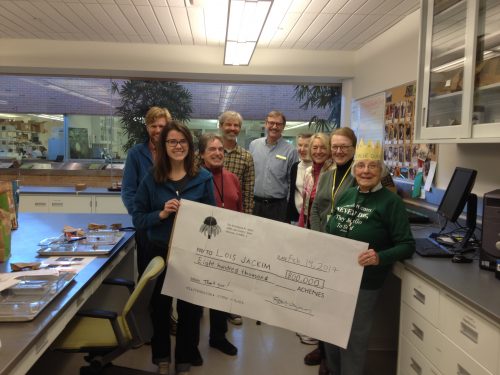|
|
Today Char and Susie have been cleaning Echinacea heads from 2016. Char is interested in Art’s idea of using the seed counter to count out achenes once they have been cleaned. She wants to know if the seed counter will be able to count achenes that come from small heads that have tons of tiny achenes. An experiment is in the works!

Lois Jackim, citizen scientist working on Team Echinacea since 2009, counted her 800,000th Echinacea achene this morning around 9:30 AM. Scientists from the Chicago Botanic Garden and Northwestern University were present as Lois was presented with a giant check thanking her for her dedication to plant science and conservation. Lois wore her “Achene Queen” crown, which she earned in 2015 after surpassing the half-million mark. Lois was not aware she was so close to the 800,000 milestone.
Counting fruits, also known as achenes in Echinacea, is a critical activity for scientists measuring reproductive fitness of plants. The Echinacea Project conducts experiments to assess environmental and genetic factors that influence plant fitness. Echinacea Project research contributes to basic ecological and evolutionary science in addition to informing conservation of perennial plants and prairies.
Other citizen scientists present this morning were cleaning and preparing seedheads and making digital images for counting. Each year the Echinacea project harvests heads from experimental plots and volunteer citizen scientists at the Chicago Botanic Garden count all achenes from each head. Citizen scientists also x-ray samples of achenes from each head to count how many of the achenes were pollinated.
 Team Echinacea celebrates Lois counting 800,000 achenes  Stuart presents Lois with a giant check to thank her for counting over 800,000 achenes.

Team Echinacea lost one of our longtime members, Bill Wallin. Last week Bill went to the hospital for pain associated with cancer and his health deteriorated quickly. He died on Monday surrounded by his family.
We will miss Bill a lot. He volunteered on Thursday mornings and has been an integral part of our team for over a decade. He was a hard working and dedicated citizen scientist and a great person to have in the lab. He was thoughtful and considerate and contributed to the ongoing discussions in the lab on wide-ranging topics. Bill was usually soft spoken and quick to smile. He would share stories of his adventures with pianos and more recently of his cancer. Through thick and thin, we could count on Bill to be a positive influence on the Team.
Bill contributed to all aspects of lab work with the Echinacea Project. In the past several years, Bill focused on counting achenes. We appreciated Bill for his speed and accuracy when counting. Since we moved to our online seed counting system in 2011, Bill has counted over 413,430 Echinacea achenes. Before joining the Echinacea project, Bill pulled weeds in natural areas at the Garden and monitored threatened plants for the Plants of Concern Program.
We will miss Bill, but we are grateful that we got to work with him and enjoy camaraderie while making contributions to plant science and conservation. We will forever have great memories.
Here is Bill’s profile from 2015 and some more posts with photos of the team and of Bill.
Hi flog,
Instead of posting from Kensington, I’m posting today from the lab computer at the Plant Conservation Science Center at the Chicago Botanic Garden. This morning, I met up with Lea (who devoted flog readers will remember from the summer) and Sam, an undergraduate Biology student at Northwestern who will be working at the Garden this Fall. Sam and I were able to bond over how the bike ride from Evanston was longer than we both expected. I also got to meet Chris and several of our excellent and expert volunteers for the first time. They taught me how to dissect heads and separate the achenes from other flower-parts (the “chaff”) and gave some helpful advice from years of their own experiences. After that, Sam and Stuart brainstormed some cool projects that Sam could get involved with. I then looked at some materials for counting and classifying achenes as full, empty, or partially-full in x-ray images using an informative tutorial that Danny wrote last year. These classifications are used to estimate seed-set size, an important part of quantifying Darwinian fitness, as well as assessing the amount (or quality) of pollen these flowers are receiving.
 Volunteers show Sam, Lea and me how to dissect heads and count achenes. From left, Suzanne, Bill (in back), Char, me, Art, Aldo, Sam, Lea, Susie.
The Echinacea Project depends on a team of volunteers to process Echinacea heads collected in the field. In 2014, our 19 volunteers devoted 1915.25 hours to the Echinacea Project! Below is a summary of hours for 18 volunteers (I will update this post once I track down hours for the last volunteer).
|
Initials |
Hours |
| 1 |
AA |
164.00 |
| 2 |
LB |
47.25 |
| 3 |
ACo |
106.75 |
| 4 |
ACr |
205.75 |
| 5 |
KE |
72.00 |
| 6 |
SG |
21.00 |
| 7 |
SH |
38.00 |
| 8 |
LJ |
130.00 |
| 9 |
SK |
16.00 |
| 10 |
MK |
26.00 |
| 11 |
ML |
41.00 |
| 12 |
BM |
219.50 |
| 13 |
LO |
68.50 |
| 14 |
LP |
105.50 |
| 15 |
NS |
93.00 |
| 16 |
CS |
230.00 |
| 17 |
ST |
122.00 |
| 18 |
WW |
171.00 |
We are so thankful for this incredible group of people, the Echinacea Project would not be possible without their hard work and dedication!
|
|





